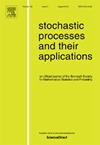Birth-death processes are time-changed Feller’s Brownian motions
IF 1.2
2区 数学
Q3 STATISTICS & PROBABILITY
引用次数: 0
Abstract
A Feller’s Brownian motion refers to a Feller process on the interval that is equivalent to the killed Brownian motion before reaching 0. It is fully determined by four parameters , reflecting its killing, reflecting, sojourn, and jumping behaviors at the boundary 0. On the other hand, a birth–death process is a continuous-time Markov chain on with a given birth–death -matrix, and it is characterized by three parameters that describe its killing, reflecting, and jumping behaviors at the boundary . The primary objective of this paper is to establish a connection between Feller’s Brownian motion and birth–death process. We will demonstrate that any Feller’s Brownian motion can be transformed into a specific birth–death process through a unique time change transformation, and conversely, any birth–death process can be derived from Feller’s Brownian motion via time change. Specifically, the birth–death process generated by the Feller’s Brownian motion, determined by the parameters , through time change, has the parameters: where is a sequence derived by allocating weights to the measure in a specific manner. Utilizing the pathwise representation of Feller’s Brownian motion, our results provide a pathwise construction scheme for birth–death processes, addressing a gap in the existing literature.
生-死过程是随时间变化的费勒布朗运动
Feller 's brown movement是指在区间[0,∞)上的一个Feller过程,它在达到0之前相当于被杀死的brown运动。它完全由四个参数(p1,p2,p3,p4)决定,反映了它在边界0处的杀死、反射、逗留和跳跃行为。另一方面,生-死过程是N上具有给定生-死q矩阵的连续时间马尔可夫链,它由三个参数(γ,β,ν)表征,这些参数描述了它在边界∞处的杀伤、反射和跳跃行为。本文的主要目的是建立费勒布朗运动与生-死过程之间的联系。我们将证明任何费勒布朗运动都可以通过唯一的时间变化变换转化为特定的生-死过程,反之,任何生-死过程都可以通过时间变化从费勒布朗运动中推导出来。具体来说,由参数(p1,p2,p3,p4)决定的Feller 's brown运动产生的生-死过程,通过时间的变化,有如下参数:γ=p1,β=2p2,νn=pn,n∈n,其中{pn:n∈n}是通过对测度p4按特定方式分配权重而得到的序列。利用Feller 's brown运动的路径表示,我们的研究结果为出生-死亡过程提供了一种路径构建方案,解决了现有文献中的空白。
本文章由计算机程序翻译,如有差异,请以英文原文为准。
求助全文
约1分钟内获得全文
求助全文
来源期刊

Stochastic Processes and their Applications
数学-统计学与概率论
CiteScore
2.90
自引率
7.10%
发文量
180
审稿时长
23.6 weeks
期刊介绍:
Stochastic Processes and their Applications publishes papers on the theory and applications of stochastic processes. It is concerned with concepts and techniques, and is oriented towards a broad spectrum of mathematical, scientific and engineering interests.
Characterization, structural properties, inference and control of stochastic processes are covered. The journal is exacting and scholarly in its standards. Every effort is made to promote innovation, vitality, and communication between disciplines. All papers are refereed.
 求助内容:
求助内容: 应助结果提醒方式:
应助结果提醒方式:


